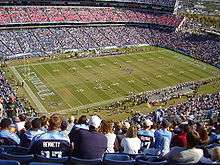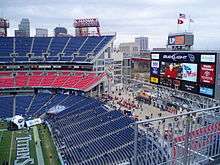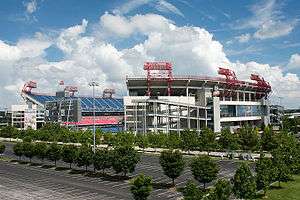Nissan Stadium
|
| |
|
Exterior view in 2009 with previous LP Field signage | |
| Former names |
Adelphia Coliseum (1999–2002) The Coliseum (2002–2006) LP Field (2006–2015) |
|---|---|
| Address | 1 Titans Way |
| Location | Nashville, Tennessee |
| Coordinates | 36°9′59″N 86°46′17″W / 36.16639°N 86.77139°WCoordinates: 36°9′59″N 86°46′17″W / 36.16639°N 86.77139°W |
| Owner | Metropolitan Government of Nashville and Davidson County |
| Operator | Metropolitan Government of Nashville and Davidson County |
| Executive suites | 177 |
| Capacity |
67,700 (1999)[1] 68,498 (2000)[2] 68,798 (2001)[3] 68,804 (2002)[4] 68,809 (2003)[5] 68,932 (2004)[6] 69,149 (2005)[7] 69,143 (2006–present)[8] |
| Surface | Tifsport Bermuda Sod |
| Construction | |
| Broke ground | May 3, 1997[9] |
| Opened | August 27, 1999 |
| Construction cost |
US$290 million ($413 million in 2016 dollars[10]) |
| Architect |
Populous (company)[11] McKissack & McKissack[11] Moody Nolan[11] |
| Project manager | The Larkin Group[11] |
| Structural engineer | Thornton Tomasetti[12] |
| Services engineer | M-E Engineers, Inc.[11] |
| General contractor | The Stadium Group, comprising Bovis, Jones & Jones Construction and Beers Construction[13] |
| Tenants | |
|
Tennessee Titans (NFL) (1999–present) Tennessee State Tigers (NCAA) (1999–present) Music City Bowl (NCAA) (1999–present) | |
Nissan Stadium is a multi-purpose stadium in Nashville, Tennessee, United States, owned by the Metropolitan Government of Nashville and Davidson County. It is primarily used for football and is the home field of the Tennessee Titans of the National Football League (NFL) and the Tennessee State Tigers of Tennessee State University. The stadium is also the site of the Franklin American Mortgage Music City Bowl, a postseason college football bowl game played each December, and is occasionally used as a venue for soccer matches. Nissan Stadium is used for large concerts, such as the CMA Music Festival nightly concerts which take place for four days every June. Facilities are included to enable the stadium to host other public events, meetings, parties, and gatherings.
Nissan Stadium is located on the east bank of the Cumberland River, directly across the river from downtown Nashville and has a listed seating capacity of 69,143.[14][15] Its first event was a preseason game between the Titans and the Atlanta Falcons on August 27, 1999. Since opening in 1999 it has been known by multiple names, including Adelphia Coliseum from 1999 to 2002, The Coliseum from 2002 to 2006, and LP Field from 2006 to 2015.
The stadium features three levels of seating, with the lower bowl completely encompassing the field. The club and upper levels form the stadium's dual towers, rising above the lower bowl along each sideline. All of the stadium's luxury suites are located within the towers. Three levels of suites are located in the stadium's eastern tower: one between the lower and club levels, and two between the club and upper levels. The western tower has only two levels of suites, both between the club and upper levels. The pressbox is located between the lower and club levels in the western tower. Nissan Stadium's dual videoboards are located behind the lower bowl in each end zone.
The playing surface of Nissan Stadium is Tifsport Bermuda Sod, a natural grass. However, the relatively warm climate of Nashville, combined with the wear and tear of hosting a game nearly every weekend, usually results in a resodding of the area "between the hashes" in late November.
On Nissan Stadium's eastern side is the Titans Pro Shop, a retail store which sells team merchandise. It remains open year-round and maintains an exterior entrance for use on non-event dates.
History

During the 1995 NFL Preseason, the Houston Oilers faced the Washington Redskins in an exhibition game at Neyland Stadium in Knoxville, Tennessee. At the game, Oilers owner Bud Adams met Nashville Mayor Phil Bredesen and began discussing the possibility of moving the team to Middle Tennessee, due to Adams' discontent with the team's lease at the Astrodome and unwillingness of the City of Houston to build a new football-only stadium. Later that fall, Adams and Bredesen announced the team's intent to move to Nashville. The city and team decided to locate a stadium on the eastern bank of the Cumberland River in downtown Nashville, on the site of a blighted industrial development.
In a special referendum on May 7, 1996, voters in Metropolitan Nashville/Davidson County voted to approve partial funding of the proposed stadium. The vote, which allocated US$144 million of public money to the project, passed with a 59% majority.[16] The pro-stadium organization, known as "NFL Yes!" outspent the anti-stadium group by a ratio of 16:1 during the campaign.
The funds initially would be raised through an increase in the Metro water tax. The ongoing funding is through a 300% increase in Davidson County individual homeowner property taxes. Much of the remaining construction costs were funded through the sale of personal seat licenses. Some State of Tennessee money was allocated to the project, on the condition that the Tennessee State University football team move its home games there, and with the request that the team be named "Tennessee" (instead of "Nashville"), which the franchise was planning to do anyway, in an attempt to appeal to the broader region.
The stadium's construction was delayed when the construction site was hit by a tornado that struck downtown Nashville on April 16, 1998 and destroyed several cranes, but the stadium opened in time for the first scheduled event.
On May 3, 2010, the stadium's playing surface was covered with six feet of water due to the heavy rains and flooding from the Cumberland River. The flood also reached down to the locker rooms of the stadium.[17][18]
The stadium received upgrades during the summer of 2012. Among the improvements are a new sound system, high-speed elevators to the upper levels, and LED ribbon boards mounted on the faces of the upper mezzanines. Two new high-definition Lighthouse brand LED video displays measuring 157 feet by 54 feet were installed, replacing the entire end zone scoreboard apparatuses. At the time of installation, the two boards became the second-largest displays in the National Football League (trailing only AT&T Stadium).[19]
Naming rights


During its construction, the stadium had no official name, though it was generally referred to as "The East Bank Stadium", a reference to the stadium's location on the eastern bank of the Cumberland River. Upon its completion, it was given the name "Adelphia Coliseum" in a 15-year, $30 million naming rights arrangement with Adelphia Business Solutions, a subsidiary of the larger Adelphia telecommunications company. However, after Adelphia missed a required payment and subsequently filed for bankruptcy in 2002, the agreement was abandoned and the stadium became known simply as "The Coliseum" for four years. (Adelphia itself was dissolved in 2006.)
A naming rights deal with Nashville-based Louisiana-Pacific was inked on June 6, 2006. Louisiana-Pacific, which markets itself as "LP Building Products", paid $30 million over 10 years for naming rights.[20] LP's influence inside the stadium led to the creation of the LP Building Zones in 2007, located beneath the giant scoreboards from Daktronics at the north and south ends of the stadium. The concession stands and restrooms in these two areas were decorated to look like suburban homes using LP products.
On June 24, 2015, car manufacturer Nissan, which has its North American headquarters just south of Nashville in Franklin and operates a large manufacturing plant in nearby Smyrna, bought the naming rights for the stadium in a 20-year contract, rebranding the stadium as Nissan Stadium.[21][22] As part of the sponsor agreement, a 2016 Nissan Titan pickup truck was placed next to the stadium scoreboard.[23]
Tennessee Titans

The Titans have posted an impressive record at Nissan Stadium since moving there in 1999, including winning their first 16 games before losing to the Baltimore Ravens on November 12, 2000. Overall, the Titans are 45–27 in the regular season and 2–2 in playoff games at Nissan Stadium. Every Titans home game (including preseason) has been a sellout since the stadium opened in 1999. This is due to fans purchasing season tickets associated with the personal seat licenses each season ticketholder must own. The seat licenses helped finance construction of the stadium. There is a long waiting list for personal seat licenses, as well as season tickets.
Music City Miracle
On January 8, 2000, one of the most memorable and debated plays in NFL history took place at then-Adelphia Coliseum. The "Music City Miracle", as it has come to be known, was a last-minute trick play on a kickoff return that resulted in a touchdown and catapulted the Titans past the Buffalo Bills to the Divisional Playoffs. It also ensured that the Titans would go undefeated in the first season in the team's new home. The victory was seen in front of a franchise-record crowd.
Soccer
Nissan Stadium regularly hosts soccer matches featuring the United States men's national team as well as by the women's national team and visiting professional clubs. The venue was first used for soccer on April 20, 2004 in an exhibition game between the Los Angeles Galaxy of Major League Soccer and Tecos UAG of the Mexican Primera División.[24] Since then Nissan Stadium has been used for friendly matches by the U.S. women versus Canada in 2004, a return of Tecos against rival F.C. Atlas in 2005, and the U.S. men versus Morocco in 2006.[25] The stadium helped host the CONCACAF men's 2008 and 2012 qualifying tournaments for the 2008 and 2012 Summer Olympics.[26][27]
On April 1, 2009, the U.S. men's national team played a World Cup qualifier beating Trinidad and Tobago, 3–0. The match saw Jozy Altidore become the youngest American to score a hat trick for the national team.[28][29] The U.S. men returned March 29, 2011 falling to Paraguay in a friendly before a record crowd of 29,059 – the largest to attend a soccer game in the state of Tennessee.[30]
Concerts and events
Nissan Stadium can also serve as a large concert venue. The main stage for the annual CMA Music Festival, held every June, is located in the stadium.
References
- ↑ "Titans Name Their New Stadium". Beaver County Times. July 8, 1999.
- ↑ "Vols, Titans Find Tennessee Big Enough for Both of Them". Harlan Daily Enterprise. September 7, 2000.
- ↑ "Titans Fans Salute". Daily News. November 5, 2001.
- ↑ "Vols Prepare for Opener in Nashville". The Tuscaloosa News. August 25, 2002.
- ↑ "Home Openers Have Gone Raiders' Way – SFGate". San Francisco Chronicle. September 11, 2003. Retrieved October 17, 2011.
- ↑ Weir, Tom (September 20, 2004). "Colts heat up in second half to sink Titans 31–17". USA Today. Retrieved October 17, 2011.
- ↑ "Raiders won't throw it back". Inside Bay Area. October 31, 2005. Retrieved October 17, 2011.
- ↑ Peters, Craig. "Titans (1–1) to Host Broncos (1–1) Sunday at LP Field". Titansonline.com. Retrieved October 17, 2011.
- ↑ "Ground Is Broken for Nashville Stadium". Milwaukee Journal Sentinel. May 4, 1997. Retrieved October 17, 2011.
- ↑ Federal Reserve Bank of Minneapolis Community Development Project. "Consumer Price Index (estimate) 1800–". Federal Reserve Bank of Minneapolis. Retrieved October 21, 2016.
- 1 2 3 4 5 "LP Field". Ballparks.com. Retrieved February 6, 2014.
- ↑ "Sports" (PDF). Thornton Tomasetti. Retrieved October 17, 2011.
- ↑ "Patrinely Group". Patrinely Group. Retrieved October 17, 2011.
- ↑ "LP Field Overview". Tennessee Titans. Retrieved May 22, 2011.
- ↑ "LP Field: About". LP Field. Retrieved May 22, 2011.
- ↑ The NFL Oilers: A Case Study in Corporate Welfare | The Foundation for Economic Education: The Freeman, Ideas on Liberty
- ↑ "Nashville flooding hits Grand Ole Opry". USA Today Online. May 3, 2010. Retrieved May 3, 2010.
- ↑ Mullen, Bryan (May 3, 2010). "UPDATED: LP Field, Bridgestone Arena Flooded". The Tennessean.
- ↑ ANC Sports :: ESPN Aug. 23 – 8:00pm
- ↑
- ↑ "Titans Announce Nissan Partnership; Stadium Rebranded as Nissan Stadium" (Press release). Tennessee Titans. June 24, 2015. Retrieved June 25, 2015.
- ↑ Wyatt, Jim (June 24, 2015). "Titans' stadium LP Field to be renamed Nissan Stadium". The Tennessean. Retrieved June 25, 2015.
- ↑ 2016 Nissan Titan XD Gets Preferred Parking At Titans’ Stadium - Truck Trend, 18 August 2015
- ↑ "Soccer hits Coliseum tonight". Nashville City Paper. Retrieved November 14, 2008.
- ↑ "Coliseum to Host US World Cup Warm-up". Nashville City Paper. Retrieved November 14, 2008.
- ↑ Nashville lands Olympic soccer qualifier | www.tennessean.com |
- ↑ "U.S. Soccer to Host 2012 CONCACAF Men's Olympic Qualifying Tournament in Nashville, Carson, Calif., and Kansas City". U.S. Soccer Federation. Retrieved November 11, 2011.
- ↑ "U.S. Finds a Future Star During World Cup Qualifier". The Tennessean. April 2, 2009. Retrieved May 1, 2009.
- ↑ "World Cup Soccer Qualifier Sweeps Nashville Off its Feet". The Tennessean. April 2, 2009. Retrieved May 1, 2009.
- ↑ "U.S. Men's National Team Falls 1–0 to Paraguay in Front of Record Crowd at Nissan Stadium in Nashville". U.S. Soccer. March 29, 2011. Retrieved January 24, 2012.
External links
| Wikimedia Commons has media related to Nissan Stadium. |
| Events and tenants | ||
|---|---|---|
| Preceded by Vanderbilt Stadium |
Home of the Tennessee Titans 1999 – present |
Succeeded by current |
| Preceded by Vanderbilt Stadium |
Home of the Music City Bowl 1999 – present |
Succeeded by current |
| Preceded by Hale Stadium |
Home of the Tennessee State Tigers 1999 – present |
Succeeded by current |
